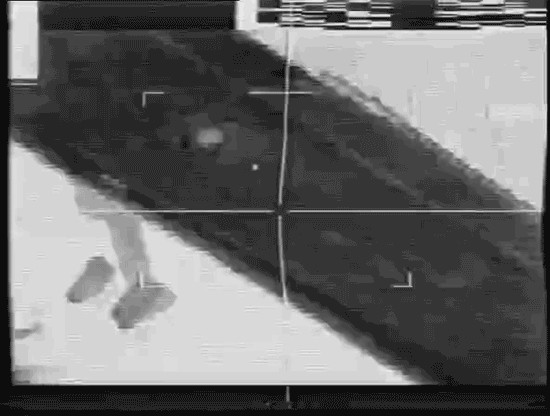Something new was happening in the world of images, something that the theoretical tools of visual studies and art history couldn’t account for: the machines were starting to see for themselves. Harun Farocki was one of the first to notice that image-making machines and algorithms were poised to inaugurate a new visual regime. Instead of simply representing things in the world, the machines and their images were starting to “do” things in the world. In fields from marketing to warfare, human eyes were becoming anachronistic. It was, as Farocki would famously call it, the advent of “operational images.”
The first time I saw Farocki’s Eye/Machine III at the Pacific Film Archive, I was confused. Moving and squiggly arrows on a video screen show how a robot “sees” and navigates a landscape. Animated dashes show the trajectory of a cruise missile. Green boxes float around the screen, showing how a computer vision system tracks and targets moving objects. I couldn’t quite understand why he thought these bits of visual military-industrial-complex detritus were worth paying much attention to. In retrospect, perhaps I was meant to be baffled by the images in Eye/Machine III because, in fact, they’re baffling to human eyes. Farocki’s was trying to learn how to see like a machine.
Throughout his career, Farocki’s method was to look into the dark and invisible places where images get made. Insisting on the material processes that construct images and the materiality of images themselves, Farocki entered the sound stages, editing rooms, post-production houses, and techno-military laboratories. In works like An Image and Deep Play Farocki turned his lens towards the creation of spectacles. In other works like I Thought I Was Seeing Convicts and Ausweg/A Way, he located image-making within apparatuses of surveillance and domination. Farocki’s work consistently showed how seeing itself is continually destroyed and reconfigured in the service of militarism and capitalism. He looked around, he watched, he documented, he demystified.
A lot has happened since Farocki’s turn toward “operational images” in the early 2000s. Images are at once becoming more powerful, and the means through which they’re produced have become ever darker.


We’re quickly approaching (and have in fact probably long past) a moment where most of the images in the world are descendants of the “operational” images in Eye/Machine: namely images made by machines for other machines. From quality control systems in manufacturing to Automated License Plate Readers (ALPR) throughout cities, and from retail motion tracking systems in supermarkets and malls to automated pattern-recognition systems in military drones, images are operating upon the world on a scale orders of magnitude greater than at the moment of Eye/Machine. Farocki’s dramatic exploration of the emerging world of operational images is now anachrononistic.
An anecdote: a few years ago, I began a little research project into operational images. The task was to ask what a contemporary version of Eye/Machine would look like (the decade that had passed since Eye/Machine is an awfully long time in technology). After about six months of research, I came to a rather dramatic conclusion. Increasingly, operational images are not simply alien to humans—they are literally invisible. In retrospect, there’s a kind of irony in Farocki’s Eye/Machine. Farocki’s film is not actually a film composed of operational images. It’s a film composed of operational images that have been configured by machines to be interpretable by humans. Machines don’t need funny animated yellow arrows and green boxes in grainy video footage to calculate trajectories or recognize moving bodies and objects. Those marks are for the benefit of humans—they’re meant to show humans how a machine is seeing.
My research project didn’t get very far. After scores of phone calls and emails to the laboratories and companies where operational images get made, it became clear that machines rarely even bother making the meat-eye interpretable versions of their operational images that we saw in Eye/Machine. There’s really no point. Meat-eyes are far too inefficient to see what’s going on anyway. Nowadays operational images are overwhelmingly invisible, even as they’re ubiquitous and sculpting physical reality in ever more dramatic ways. We’ve long known that images can kill. What’s new is that nowadays, they have their fingers on the trigger.
The spaces that give rise to these trigger-happy images are getting darker and darker, both through military and corporate secrecy and the mechanics of seeing-machines themselves that no longer deign to make human-interpretable versions. I don’t know how we will learn to see this world of invisible images that pull reality’s levers, but I do know that it’s imperative for other artists to pick up where Farocki left off, lest we plunge even further into the darkness of a world whose images remain invisible, yet control us in ever-more profound ways.
